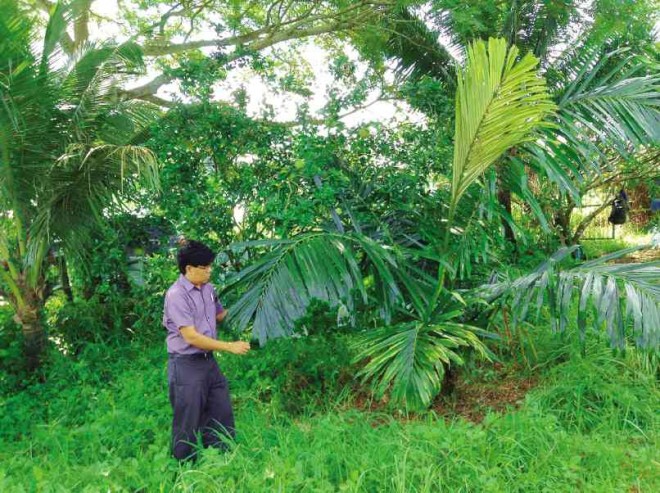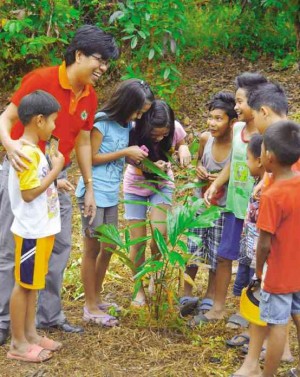‘Kaong’ more than a dessert ingredient

WONDER CROP Agroforester Dr. Lorenzo Lapitan Jr. promotes the many uses and benefits of “kaong” (sugar palm) in Indang, Cavite province. CONTRIBUTED PHOTOS
THIS underrated crop works wonders. Dr. Lorenzo Lapitan Jr., an agroforester from Indang, Cavite province, has realized the many benefits of kaong (sugar palm) other than to produce fruits commonly known as dessert ingredients.
Since 2007, Lapitan, 52, has devoted time and resources studying the crop’s byproducts and pushing it to become another industry in Indang, a first-class municipality (annual income: over P55 million) more popular for producing high-quality coffee.
“We often seek God’s blessings. But even before we open our mouths to prayers, the answers are already there—the kaong (trees) are there,” he said in a recent phone interview.
Kaong trees (Arenga pinnata) are abundant yet “underutilized” in Indang, as well as in the neighboring towns of Amadeo, Alfonso and Silang, all in upland Cavite. But experts and the communities have very little interest in the trees, Lapitan said.
“People know it only as a dessert,” he said, referring to the sweetened kaong fruit used in salads or halo-halo, a native treat. “But all parts of the plant can actually be converted for other uses.”
Article continues after this advertisementArticle continues after this advertisement
‘Trees of life’
If coconut trees are referred to as the “trees of life,” Lapitan sees the kaong as the “wonder crop.” Its leaves can be made into brooms or woven baskets, its bark into hard pieces of furniture, and its fiber, also known as yumot or Cabo negro, into ropes and cleaning brushes.
In fact, traders used to go to Indang to buy kaong ropes commonly used in the Batangas port, Lapitan said. The material is durable and lasts long even when submerged in salty water, he noted.
(But) “the most economical part of the palm is the sap,” Lapitan said.
The sap’s most common byproduct is the popular local drink tuba, which when fermented turns into kaong vinegar. Of all crops, kaong yields the highest amount of ethanol at 24,000 liters per hectare per year, Lapitan said.
Win-win solution
But not many people realize that the kaong sap, once heated, produces brown sugar, which not only serves as a natural sweetener but contains minerals and a very low glycemic index (GI), as well. GI refers to the impact of food to the blood sugar.
“This means that diabetics may now enjoy sweets without having to worry about the sugar in their bloodstream,” Lapitan said.
Kaong production, however, remains low, bringing the price of kaong sugar, for instance, to around P350 a kilo. Lapitan laments the little attention and support the crop receives from the government.

FUTURE GAINS Children are encouraged to plant and promote “kaong,” considering its almost 10-year gestation period, as it secures their future.
Since 2010, Lapitan, who is also the president of the nongovernment Habitat for Humanity in Indang, leads the planting of kaong palms. The humanitarian group also maintains a community-based kaong nursery.
“They (kaong palms) need not be planted in prime lands (and) have a very good natural regeneration if only humans won’t intervene,” he said.
Lapitan said more than a hundred NGOs and Manila-based companies had been invited to plant around 30,000 kaong seedlings in Indang farms, public lands, riverbanks and slopes. In 2013, he did not celebrate his 50th birthday with a grand party but planted kaong instead.
Each palm grows 12 to 20 meters high and takes six to 15 years to mature. A mature palm bears an average of eight fruit clusters, each cluster having as much as 5,000 fruits.
With a 90-percent survival rate and the capacity to thrive even under adverse conditions, kaong palms are also effective soil stabilizers against erosion. They also serve as a natural habitat for the alamid (mountain cats) and cloud rats.
No pest or disease in kaong palm has been reported yet, not even the cocolisap that infested coconut trees in recent years.
“If you’re going to plant kaong, both environmental protection and human livelihood can be served,” he said. At the very least, “it stabilizes slopes and at the same time helps our magtutuba (sap collectors), giving us a win-win solution.” Maricar Cinco